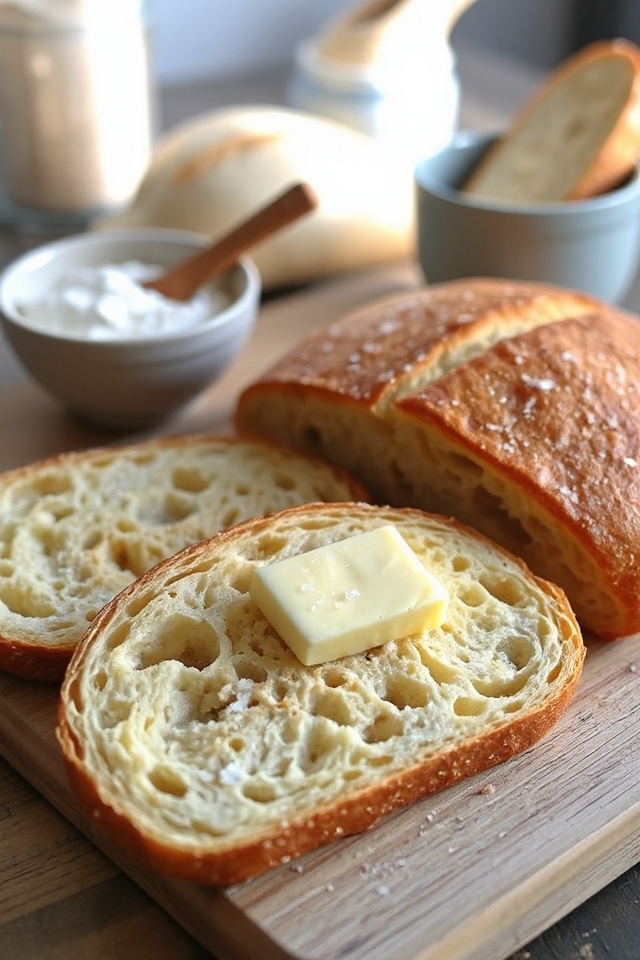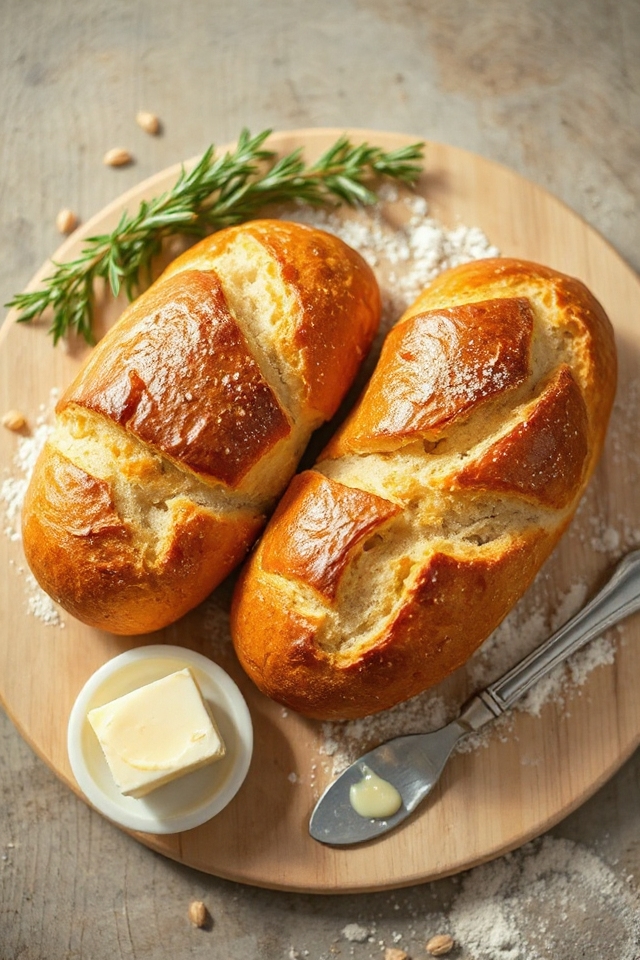Why You’ll Love This French Bread Recipe
You’ll absolutely love this French bread recipe because it’s simple and rewarding. I remember the first time I made it; the aroma filled my kitchen, making it impossible to resist. The process is straightforward, requiring just a few basic steps. Kneading the dough is therapeutic, and watching it rise gives you a sense of accomplishment. Plus, nothing beats the satisfaction of pulling a golden loaf from the oven, knowing you created it from scratch. It’s perfect for sandwiches, dipping in soups, or enjoying with butter. Trust me, this recipe will quickly become a favorite in your home.
Ingredients of French Bread
When it comes to making delicious French bread, the first step is gathering your ingredients. Don’t worry; you won’t need to hunt down anything too exotic. Most of these items are probably already in your pantry.
And if you’re anything like me, you might even have flour scattered around from your last baking adventure—what can I say, I can be a bit messy. So, let’s plunge into what you’ll need to whip up this delightful loaf!
Ingredients:
- 2 cups water
- 1/4 cup sugar
- 3 tablespoons salt
- 3 tablespoons yeast
- 6 cups flour
Now, let’s chat about these ingredients for a moment. The water is essential because it helps activate the yeast, which is what makes your bread rise. I mean, who doesn’t want a fluffy loaf?
The sugar might seem like an odd addition, but it actually feeds the yeast, giving it a little kick-start to do its magic. And salt, well, it’s not just for flavor; it also controls the fermentation process.
As for the flour, it’s the backbone of your bread. All-purpose flour works great, but if you want to experiment, bread flour might give you a chewier texture. Just remember, baking is as much about learning as it’s about following the recipe, so don’t be afraid to play around a bit.
Happy baking!
How to Make French Bread

Alright, let’s plunge into the delightful world of making French bread. It’s simpler than you might think, and the smell of fresh-baked bread wafting through your home? Absolutely worth it.
First things first, grab a large mixing bowl and pour in 2 cups of warm water. Make sure it’s warm, but not too hot—you want it to feel cozy, like a hug, not like a blazing sun. Mix in 1/4 cup of sugar and 3 tablespoons of yeast, and let them hang out for about 10 minutes. You’re looking for that bubbly, frothy top—a sure sign that your yeast is alive and ready to party.
Once you’ve got that bubbly goodness, it’s time to get serious. Add in 6 cups of flour and 3 tablespoons of salt. Now, here’s where the magic happens. If you have a wooden spoon, give it a good stir to combine everything, but I’ll be honest—your hands might be the best tools for this job.
Flour will fly everywhere (I mean, who doesn’t love a bit of kitchen chaos?), but just embrace it. Once everything is mixed, it’s kneading time. Dust your counter with a bit of flour, and turn the dough out. Knead it for about 10 minutes until it’s smooth and silky. You might start to feel like a bread-making ninja, and that’s totally okay. Just keep folding, pushing, and stretching until it feels right.
After your dough is nice and smooth, place it in a greased bowl, cover it with a kitchen towel, and let it rise in a warm spot for about an hour. It should double in size—just like your hopes and dreams.
Once it’s puffed up, punch it down gently, because we’re not savages; we’re bakers. Shape the dough into loaves (or rolls, if you’re feeling fancy) and place them in a greased baking pan. Let them rise again for about 30 minutes. This is the moment where patience pays off.
Finally, preheat your oven to 375°F and bake those beauties for 30 to 40 minutes, or until they sound hollow when you tap them. And there you have it—your very own French bread, ready to be slathered with butter or turned into a fancy sandwich. Enjoy the fruits of your labor, my friend.
French Bread Substitutions & Variations
Exploring French bread substitutions and variations can open up a whole new world of flavor and creativity in your baking.
For instance, if you’re gluten-free, try using a blend of gluten-free flours. You can also experiment with different types of flour, like whole wheat or spelt, for a nuttier taste.
Adding herbs like rosemary or thyme can elevate your loaf, while incorporating olives or sun-dried tomatoes delivers a Mediterranean twist.
If you want a sweeter bread, consider adding honey or using a bit of milk instead of water.
The possibilities are endless—get creative and enjoy the process!
Additional Tips & Notes
Although baking French bread can seem intimidating at first, a few key tips can make the process smoother and more enjoyable.
First, make certain your water is warm but not hot; it should feel like a warm bath to your wrist. Use a kitchen scale if you have one—it guarantees accuracy in measuring flour.
Don’t rush the kneading; aim for that smooth, elastic texture. Finally, let the dough rise in a warm place, covered with a damp cloth. This helps it rise beautifully.
And remember, practice makes perfect. Your first loaf may not be perfect, but it’ll still be delicious!
